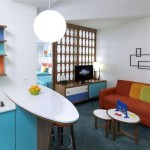What Color Represents Interior Design?
Color is an essential element of interior design, influencing the mood, atmosphere, and overall aesthetic of a space. It's more than just a visual element; it has a profound impact on our emotions, behavior, and even our physical well-being. Understanding the psychology of color and its role in interior design is crucial for creating spaces that are not only visually appealing but also functional and conducive to the desired mood and purpose.
The Psychology of Color in Interior Design
Colors evoke specific emotions and associations. Warm colors, such as red, orange, and yellow, are often associated with energy, passion, and excitement. They can stimulate appetite and conversation, making them suitable for dining rooms or kitchens. Cool colors, such as blue, green, and purple, are generally associated with calmness, serenity, and relaxation. They can create a sense of tranquility and are often used in bedrooms and bathrooms.
Neutral colors, such as white, gray, and beige, provide a blank canvas for other colors to shine. They are versatile, serving as a backdrop for bolder accents and creating a sense of spaciousness. Black, while often associated with sophistication, can also be overpowering if used excessively. It is best used in small doses to create contrast and depth.
Using Color to Create Different Moods
The strategic use of color can create a variety of moods and atmospheres within a space. For instance, a vibrant yellow in a living room can create a cheerful and welcoming ambiance, while a serene blue in a bedroom can promote relaxation and sleep. If a space is overly bright or sterile, incorporating warmer tones like terracotta or peach can bring a sense of warmth and comfort. In contrast, adding cool colors like mint green to a space that feels too heavy or dark can create a sense of airiness and tranquility.
By understanding how color impacts mood, designers can create spaces that cater to specific needs and preferences. For example, a home office might benefit from energizing colors like red or orange to enhance focus and productivity, while a meditation space might benefit from calming blues or greens to promote relaxation and mindfulness.
Choosing the Right Color Palette
Creating a cohesive color palette is crucial for a successful interior design project. One approach is to start with a focal point, such as artwork or furniture, and pull out colors from that piece to create a foundation for the overall color scheme. Another common approach is to use a color wheel and select complementary colors, which sit opposite each other on the wheel, or analogous colors, which sit next to each other.
It is important to consider the natural light of a space when choosing colors. For instance, rooms with limited natural light might benefit from lighter colors to reflect more light, while rooms with abundant natural light can accommodate darker shades.
Ultimately, the choice of color is a personal one, and there are no hard and fast rules. Experimenting with different shades and combinations is encouraged to find what feels best for the space and the individual who will be inhabiting it.

The Psychology Of Colors In Interior Design Foyr

15 Interior Design Charts That Will Turn You Into A Decorating Pro Feng Shui Guide Colours

Color Theory Basics How To Use For Interior Design Foyr

The Psychology Of Colors In Interior Design Foyr

Colors And Emotions Color Psychology Meanings Interior Design Schemes

Color Theory Basics How To Use For Interior Design Foyr

The Psychology Of Color In Interior Design Meanings

Color Meanings And Symbolism Colors In Interior Design Oriental Rugs

The Psychology Of Colors In Interior Design Foyr

What Can Color Psychology Tell Us About Interior Design Trends








